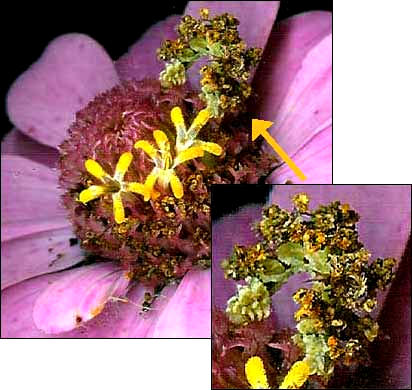Excerpts from Jim Conrad's
Naturalist Newsletter
from the August 3, 2006 Newsletter, issued from Polly's Bend, Garrard County, in Kentucky's Bluegrass Region:
WAVY-LINED EMERALD CATERPILLAR ON THE ZINNIAS

A pretty row of pink and white Zinnias grows along a white shed next to the old farmhouse I'm in. The other day on one of those Zinnias I saw the amazing thing at the right.
That image shows one of the best examples of a well-camouflaged caterpillar you'll ever see. The inset at the lower right shows a close-up of the caterpillar and I'll bet that some of you still can't figure out where the caterpillar is, even knowing that. In the inset, the caterpillar is arched like an upside-down U. On the arch's left side you can see six white caterpillar legs. This is the Wavy-lined Emerald Caterpillar, SYNCHLORA AERATA, an inchworm who camouflages himself by sticking pieces of the flower he's eating onto his back! The inchworm in the picture has attached old pollen-producing anthers from the Zinnia's disk flowers -- the tiny flowers forming the Zinnia's "eye."
Once you know you're looking at an inchworm you may be able to see it better. Remember how inchworms stretch themselves out, then arch their bodies to bring up their rear ends, plant their rear ends, and then stretch their bodies again, moving their front ends forward. In the picture the inchworm is in his arch form.
Being an inchworm, he's a member of the Geometer Moth Family, the GEOMETRIDAE. He'll metamorphose into an inch-across, greenish moth, which you can see here.
Sometimes inchworms are called measuring worms. Cankerworms are a kind of inchworm. The Wavy-lined Emerald Caterpillar on my Zinnia is about an inch long. The flower parts on its back easily come off if you pull on them.